What is Clostridium botulinum
Clostridium botulinum are Gram-positive, rod-shaped, anaerobic, spore-forming, motile bacteria with the ability to produce a neurotoxin. These bacteria are common in canned food products and therefore care must be taken especially when doing canning at home. Botulinum toxins are one of the most lethal substances known. They work by blocking nerve functions and can therefore lead to respiratory and muscular paralysis.

Food safety knowledge is for all!

Every consumer deserves to have high quality and safe food. …Read more!

Ways through which botulism may occur
Cases of human botulism may refer to:
- Foodborne botulism
- Infant botulism
- Wound botulism, and
- Inhalation botulism

Conditions for the formation of botulinum toxin
The conditions in which the spores can grow and make toxin are:
- Low-oxygen or no oxygen (anaerobic) environment
- Low acid/ pH higher than 4.5
- Low sugar – relates to osmotic potential
- Low salt – relates to osmotic potential
- A certain temperature range – there are several typesof this toxin, For instance, the minimum temperature for growth and toxin formation by C. botulinum type E and non proteolytic types B and F is 38°F (3.3°C).
- A certain amount of water – relates to water activity. Usually high water activity allows many bacteria to grow. The minimum aw at which growth and toxin formation by C. botulinum can occur has been reported to be 0.965.
How to prevent Clostridium botulinum toxin production
To prevent Clostridium botulinum toxin production, it is important to follow proper food handling and storage practices. Here are some guidelines to minimize the risk:
- Ensure proper canning and preservation techniques: If you are canning foods at home, make sure to follow tested and approved canning recipes and procedures. This includes using the appropriate processing methods, such as pressure canning for low-acid foods. Properly sterilize jars and equipment before use.
- Maintain proper temperature control: Clostridium botulinum bacteria thrive in environments with low oxygen levels, moisture, and temperatures between 40°F (4°C) and 140°F (60°C). To prevent toxin production, it is crucial to keep potentially hazardous foods out of this temperature range. Refrigerate perishable foods below 40°F (4°C) and ensure hot foods are kept above 140°F (60°C).
- Employ good manufacturing practices (GMPs): Practice good hygiene when handling and preparing food. Wash your hands thoroughly with soap and water before and after handling food. Keep utensils, cutting boards, and surfaces clean to prevent cross-contamination.
- Employ hurdle technology: Hurdle technology can be employed as a strategy to prevent toxin production by Clostridium bacteria, including Clostridium botulinum. By combining multiple hurdles or obstacles, it creates an environment that inhibits the growth and toxin production of these bacteria. Here’s how it can help:
- Temperature control: Adjusting and maintaining temperatures outside the favorable range for Clostridium growth (between 40°F/4°C and 140°F/60°C) can impede the growth and toxin production of the bacteria. Refrigeration or heat treatments like pasteurization and sterilization can be used as hurdles to control temperature.
- pH adjustment: Clostridium bacteria thrive in neutral pH conditions. By altering the pH level, typically by making it more acidic, through methods like fermentation or adding acidic ingredients, the growth and toxin production of Clostridium can be hindered.
- Water activity (aw) control: Clostridium bacteria require sufficient water activity levels to grow and produce toxins. By reducing the available water through techniques like drying, salting, or using food additives to lower water activity below the threshold for bacterial growth, the risk of toxin production can be minimized.
- Preservatives: Natural or chemical preservatives can inhibit the growth and toxin production of Clostridium. Antimicrobial agents can be used as hurdles to prevent bacterial growth and toxin formation.
- Packaging: Utilizing proper packaging techniques that provide a barrier against oxygen, moisture, and external contaminants can help create an unfavorable environment for Clostridium bacteria. This prevents their growth and subsequent toxin production.
Read more about Hurdle technology here: Harnessing the Power of Hurdle Technology in Food Preservation!
Our Blog ↗
Read the latest from our blog
Ask a Question ↗
Ask a question and get answers from our community
Give Feedback ↗
We value your feedback.


